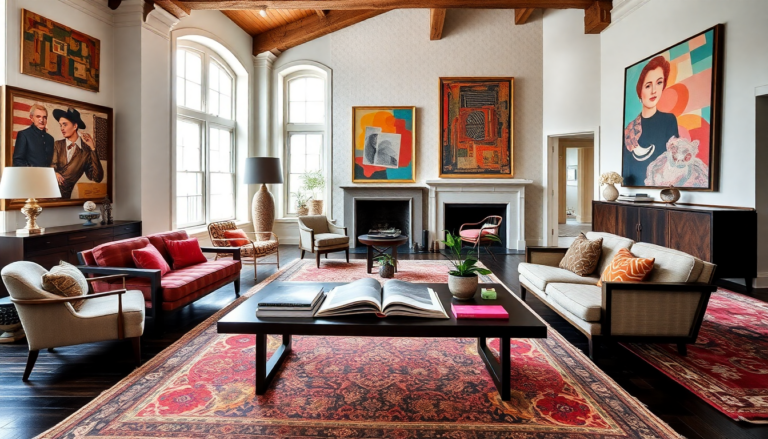Argomenti trattati
- Peter Dunham’s unexpected path to design
- Motivation behind his design book
- Influential figures and valuable lessons
- Haunting memories from a historic mansion
- Nurturing inspiration in nature
- Establishing a home’s vibe
- The art of color in design
- Drawing attention to unique features
- Signature paint choices
- Layering patterns for visual harmony
- Creating inviting gathering spaces
Peter Dunham’s unexpected path to design
Peter Dunham, a name synonymous with vibrant color and eclectic patterns, never envisioned a career in interior design during his formative years. Yet, his journey has led him to become a celebrated figure in the industry. In his debut book, The World of Peter Dunham, he offers readers a glimpse into the extraordinary homes he has inhabited and the notable influences that have shaped his aesthetic vision. With roots in France and training in England, Dunham draws from a rich tapestry of experiences to define his design philosophy, emphasizing the essential components that contribute to a successful home.
Motivation behind his design book
In our recent conversation with Dunham, he shared the motivation that fueled the creation of his design book. He felt an abundance of material worthy of a publication, particularly during the quieter moments of the COVID pandemic, which allowed him to capture his work through photography. Partnering with Vendome Press and editor Stephen Drucker transformed what initially appeared to be a daunting task into an exhilarating creative challenge. The moment he held the finished book in his hands was a culmination of his hard work and passion.
Influential figures and valuable lessons
Throughout his career, Dunham has drawn inspiration from various luminaries, including designer David Hicks and artist Salvador Dalí. When asked about the best advice he’s received, he quoted, “Acceptance is the road to happiness.” This simple yet profound insight resonates with him, guiding his approach to both design and life. It encourages a mindset that embraces challenges while remaining open to new possibilities.
Haunting memories from a historic mansion
Among the many homes that have shaped his life, Dunham recounts living in an 18th-century mansion in France that was rumored to be haunted. His parents were invited to rent a floor in the exquisite Hôtel de Noailles in Saint Germain-en-Laye, a house steeped in history and architectural grandeur. Dunham vividly recalls a childhood incident where he encountered a spectral figure—a ghostly housekeeper believed to have met a tragic fate. This experience left a lasting impression on him, intertwining his love for history and design.
Nurturing inspiration in nature
For Dunham, inspiration flows most freely in Spain, where he feels a profound connection to the natural world. While he thrives in urban environments filled with art and culture, it’s the serene landscapes and the absence of distractions that ignite his creativity. Often retreating to a place without electricity, he finds clarity and openness to new ideas. This preference for simplicity informs his design ethos, encouraging a harmonious blend of indoor and outdoor spaces.
Establishing a home’s vibe
In his book, Dunham discusses the importance of establishing a home’s vibe as a foundational aspect of his design approach. When faced with a space that lacks inherent character, he embarks on a quest to uncover its potential. This involves researching the area’s history, exploring local architecture, and immersing himself in the community’s essence. From historical landmarks to vibrant local markets, he seeks to capture the spirit of the place, ensuring that each design reflects a sense of belonging.
The art of color in design
Dunham is known for his insightful perspective on color, famously stating, “There is no ugly color, only bad uses of it.” He advocates for the transformative power of textiles, particularly velvets and silks, which can elevate even the most mundane hues into stunning jewel tones. By incorporating mismatched velvets into a room, he infuses spaces with vibrancy and texture that captivates the eye.
Drawing attention to unique features
Using color strategically, Dunham highlights distinctive features within a home, including a client’s eye color or a breathtaking view. He recalls one instance where he creatively masked an unfortunate hairpiece with an explosion of patterns and soft lighting, demonstrating his ability to divert attention and create an inviting atmosphere. This playful yet intentional use of color showcases his versatility as a designer.
Signature paint choices
When it comes to paint, Dunham’s go-to shade is Simply White by Benjamin Moore, a versatile hue that complements various design styles. He also enjoys experimenting with custom milk paints, known for their non-toxic properties and beautiful Mediterranean wash effect. This commitment to sustainability and aesthetics reflects his holistic approach to design, ensuring that each choice enhances the overall ambiance of a space.
Layering patterns for visual harmony
Dunham emphasizes the significance of balancing positive and negative prints when layering patterns within a room. Positive prints typically feature motifs on light backgrounds, while negative prints dominate with color. He skillfully combines diverse materials and textures, creating spaces that feel cohesive yet eclectic. This method mirrors culinary art, where knowing how to blend ingredients can lead to delightful surprises.
Creating inviting gathering spaces
In his own home, Dunham prioritizes designing inviting spaces for social interaction. His living room features two distinct seating areas: one designed for larger gatherings, anchored by a cozy banquette, and another more intimate area by the street window. Each space serves a unique purpose while maintaining a harmonious aesthetic. Additionally, his dining areas cater to different atmospheres—one intimate and warm, perfect for evening meals, and the other airy and light, ideal for daytime creativity. These thoughtfully curated spaces reflect his belief in the power of design to foster connection and community.

